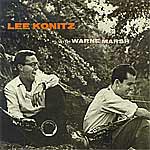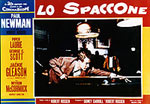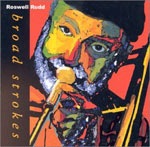Suh Blah Blah Buh Sibi | |

| Bewitching-Lee, Subconscious-Lee, Sound-Lee… I could play this game all day, but of all the adjectives used to describe Lee Konitz in album and song-titles, the following could, I feel, equally be applied, so if the great man is reading this, please take note: Beguiling-Lee Merri-Lee Deft-Lee Strange-Lee Symmetric-Lee Severe-Lee Incisive-Lee Decorative-Lee Allusive-Lee… Phew, now I've got that out of my system I can begin talking about the music. I'm sure I've mentioned enough times now that Birth of the Cool was one of the records which kick-started my interest in jazz, as influential in its on way as any product of the New York No Wave, 'Marquee Moon' or 'Gloria'. Miles photographed self-absorbedly behind those shades on the cover, the self-contained three-minute bursts of elegantly crafted arrangements by Gerry Mulligan and, most prominently, the svengali (Svenga-Lee? stop stop STOP!) Gil Evans. One of the players present at those sessions was Mr Konitz, and I've since paid my dues to him, listening with hushed reverence to cross-sections of his output, up to and including the lovely recent offering alongside Kenny Wheeler's trumpet, Angel Song on ECM. I'd still contend that the best of the man's work is to be found back in the 50's, when a range of influences were tugging at the man's horn, the kind of force-fields which take your instrument and bend it out of shape overnight. What else could explain the bizarre metamorphosis which took hold of Dizzy Gillespie's trumpet for instance, giving it the pummelled consistency of Jack Johnson's punching-bag. Wasn't there a line in a hip hop record by The Isolationist from last year which threatened to do the same thing, the inspired 'hydrogen slush/ your ears are my punching bag'? So the best of Konitz is at once cerebral and taxing, and given to its moments of playful insouciance. The record in question is the Atlantic date from 1955, Lee Konitz With Warne Marsh. As if a proper title would be so much extra flesh on neatly hewn sinew, they chose to do without. I'm not one to resist a challenge, so if I were called upon to provide one, it would be The Chess Players. The music presents angular rhythms, the players shadowing each other without yielding their own conception of how they play, Lee's robust alto heard in unison with Warne's teasing tenor sax twitching neurotically against and inside his instrument, a series of responses and strident affirmations. All the while the pieces are being reinvented, invested with the explosive dammed-up energies typical of a chess game. This wouldn't be any chess game I've ever been involved in, more like Bobby Fischer vs Boris Spassky and the accusations of hypnotism and rays from outer space which surrounded them. Star wars on a chess board, less a product of the Cold War than the Cool War, using Uri Geller techniques to bend and shape staid showpieces into something else. It's music which is safely assumed to reside at the opposite end of the spectrum from the frenetic turbo-charged psyches of free jazz, the Grand Prix racers of jazz blowing, but wasn't Prost nicknamed the Professor when he was still driving rather than managing F1 cars? Surely the speed and intensity of the best chess games threaten to tear the player apart with the irresistible G-force dragging them towards the board. |

| The composition 'Two Not One' is maddening for precisely that reason for the first listens, with its Tristano traits of surges of raw improvisation, wire-thin lines stretched out and charged with electric currents of drive, with the emotional energy pegged back so as to offer the mind matter for intellectual absorption. Lennie Tristano is a huge influence here, a blind pianist with a massive presence, a player who combines the energy of (also blind) Art Tatum with the mathematical precision of Bach's enormous structures. Warne is the kind of player who cuts very quickly to the essence of things, and in every context I've heard him play he spurs his fellow players to shake off excess baggage. Alongside altoist Art Pepper on The Way It Was! Art plays with tremendous focus, pouring out fresh ideas and being coaxed by the endlessly resourceful Marsh into crafting exquisite lessons in intuitive understanding. I'm convinced the pianist calling himself Sal Mosca on the Konitz record is a pseudonym. Some names are almost TOO knowingly hip to be true- the word 'mosca' means fly in Italian I believe, and his piano playing is pretty fly too. I love to think it was Kerouac taking the day off, the fly in the ointment. The cover captures the duo in a relaxed moment in leafy surroundings, one of the most strikingly beautiful jazz sleeves. Warne wryly posing, smiling but you detect an air of impatience about him, gaze averted, as if any time away from his instrument means less time to surge forward and develop new tonalities, push the boundaries out a little further. Konitz on the other hand is laughing uproariously, clearly something or someone is flying past off-camera- that'll be superfly Sal Mosca, attempting to take off on some contraption he's devised under the influence. The album ends with 'Background Music', which speeds along with enough assurance to draw from Konitz some of his most compelling grouchy comments on alto, twinned with the dedicated harmonic allure cast over proceedings by Marsh. Composed by Marsh, with a characteristically elusive title, self-effacing but the more seductive for the blanket it casts over your expectations. The pals pack up their horns and leave the studio. The chess pieces return to the box. Stop the clock. |

| It's as background music too that I was surprised and delighted to encounter the great trombonist Roswell Rudd in the party sequence in The Hustler. It's a great scene, with the New Orleans band blaring away gloriously until Piper Laurie explodes at George C. Scott, at which point the music ceases. This being Hollywood, it magically starts up again a second after the row has died down. Of course. Being named Roswell Rudd probably explains the man's obsession with mysterious names and nonsense titles. Was it the double 'R' which attracted esteemed director Robert Rossen to the trombonist then? I love Rossen's films, and he was one of the few successful writer-directors from the 40's to the 60's to be open to new ideas about filmmaking, casting his films off the beaten track, drawing on uncompromising source material, and imbuing his films with an unmistakably dark feel. His most daring female characters are riddled with ambiguities, under the influence in some way, years before Cassavetes made the stark and devastating film of the same name. There's no finer example than his final film Lilith, where he dares to project onto the lead characters his own awareness of his failing health and fear of fragmentation. Another double 'R', Hollywood gossip columnist Rex Reed, claims in one of his pieces of reportage that the tension between the director and Warren Beatty and others came from his shooting in a state of ignorance of his failing health. Such is the potency of those scenes in the labyrinths of the asylum grounds that I'd be tempted to draw the opposite conclusion. The fragile connections between Beatty and the wonderful Jean Seberg again have more to do with the psychology of chess than escapism and easy answers, so that the film can stand alongside his earlier explorations of game-playing as metaphors for self-delusion and degradation, following pool (The Hustler), bull-fighting (The Brave Bulls) and boxing (the John Garfield tour de force Body and Soul). RR's signature is as authentic and unmistakable as Godard's (JLG) or the K for Kubrick. The landscape scenes are as ravishing in monochrome as the picturesque Konitz/Marsh sleeve, with the difference that Rossen enjoys cutting away to torrential rushes mid-conversation, as daring as Godard of the period. It's not necessary to read the actors' lips, tensions threaten to irrupt in schizophrenic fashion, Seberg exposed and cornered by turns. It's as harrowing and painful a film as you could imagine, but invested with genuine sympathy for the uprooted victim. A kind of visual accompaniment to Big Star's 'Holocaust' from Sister Lovers or Sonic Youth's 'Schizophrenia' from Sister. |

| By ESP or other hallucinatory coincidence, Sonic Youth have joined forces with Roswell Rudd on his new record, Broad Strokes, on New York's ultra-hip Knitting Factory records. A fact which brings to mind Rudd's early forays into free jazz with the great New York Art Quartet alongside John Tchicai, who'd later feature on John Coltrane's Ascension. His long-standing interest in ethnic origins lay behind the formation of the Primordial Quintet with Lee Konitz in the 60's, but he hasn't made a record as a leader for two decades, more a case of a dormant force than a spent one. This is easily the jazz event of the year, though run a close second for me by Sheila Jordan's recent appearance in Cambridge, where the Kettle's Yard gallery played host to her. The birds outside seemed utterly charmed by her, perhaps in anticipation of her version of Bird's 'Confirmation', and her jaunty scatting was easily as inspired as the Gaudier-Brzeskas and Ezra Pounds surrounding her. Sheila also appears on the new Rudd offering, recalling her sensational work on his earlier Flexible Flyer. Words fall way short of describing the sinister effect of her interplay with his lupine trombone and gruff voice on that album's 'Suh Blah Blah Buh Sibi', a dark primitive growl set off against her insistent vocalizing. It's that primordial explosiveness which comes to mind first when I think of the Professor Rudd, for he is also an expert on ancient African and Oriental cultures, which aligns him with his hero Herbie Nichols, the Dada revolt of Archie Shepp and the volcanic Leroi Jones of Preface to a Twenty Volume Suicide Note. His playing has always been filled with crazed Dada exuberance, making his one trombone sound like seventy-six sabre-toothed drills boring their way through your consciousness. In jazz terms he could combine the carefree abandon of trombonist Melba Liston, her style the equal of the matter-of-fact aloofness of Dexter Gordon on their recordings together, with the raunchy huff and puff of New Orleans Dixieland. In classical terms there's only Magnus Lindberg who can launch himself into abstract swathes of trombone carved from dense forbidding subject matter by Ligeti with similar vehemence. While the big bad wolf Rudd's focus here is more mellow, choosing to play ballads in the most drawn-out style possible, none of the impish, impious humour has disappeared. 'Sassy and Dolphy' is inspired by the names of two dogs, one being Roswell's German Shepherd. 'Stokey' is inspired by the delights of Stoke Newington, which makes a change from leaving your heart in San Francisco or having Georgia on your mind. It's also a treat to hear another avant-gardist present and correct on a Monk cover, 'Coming On the Hudson', the soprano saxist Steve Lacy. There are far too many riches to list in trite fashion here- needless to say he works wonders with Elvis Costello's 'Almost Blue', a surprising choice but not so surprising given Costello's jazz influences and Rudd's magical way with the sound of a blues snake-bite. 'God Had A Girlfriend' speaks for itself. The Sonic Youth track is 'Theme From Babe' from Camille Saint-Saens' Third Symphony. Enough said. Sit up and Listen up. On Sheila Jordan's visit to these parts, I was sorely tempted to pester her during the interval, but was too starstruck to ask her about working with Rudd or Herbie Nichols. Or where on earth the phrase 'Suh Blah Buh Sibi' was conjured from. In retrospect I'm glad I didn't. Some mysteries are best left unsolved. © Marino Guida 2000 |